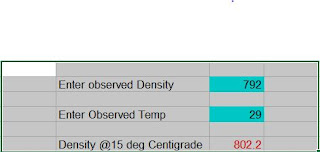Jet A-1 Density conversion to 15 C from observed temperature without ASTM tables
Jet A-1 Density conversion to 15 C from observed temperature without ASTM tables
Globally Oil industry Quality Manuals specify certain tolerance density variation for petroleum products like Gasoline, Diesel fuels, Aviation fuels etc, between density of dispatched products and density of received product. As long as this density difference remains less than permitted variation, the product is accepted in the system.List of all blog articles on Petroleum QC by RJ Patel.
In
India, for Aviation products, this quality control variation in density number
is +/- 2.5 kg/m3 against JIG specified variation +/-
3.0 kg/m3 maximum. During Aviation products transfer from one
place to another using Ocean tanker, pipeline, Rail T/Ws, Road Tank Truck etc.
Density at 15 deg C is recorded at despatch and receipt end.
A
simple way of converting observed density from ambient temperature to 15 deg C
has been developed, without ASTM tables, using simple steps which can be
performed without calculator.
Lists of Android/iOs Apps developed on Petroleum Calculation - see here. (These apps convert Density/API gravity exactly as per ASTM tables 5a, 5b, 6a, 6b, 23a,23b, 24a,24b, 53a,53b, 54a,54b to standard temperature 15 C, 20 C and 60 F.)
Difference from
this method comparing to actual ASTM table, without using ASTM tables is usually after decimal point that
also less than 0.4 kg/m3 one need to
remember that usually persons read hydrometers and thermometers without
considering the eye approximation between digits, which any way cause error
of more than 0.4 kg/m3.
A) Simplified Formula
D15 = do +
10 + 0.7 x ( to – 28.5)
Where
D15 = density at 15 Deg C,
do = density at observed temperature of sample
to = observed temperature of sample
Temperature unit is Deg C and Density unit is kg/m3
B) How
to use formula manually without calculator
Example 1:
Density observed = 792.0 kg/m3
Temp.
Observed = 30.5 deg c
ASTM table 53 B = 803.2 kg/m3
Steps
: 1) add 10 to observed
density ie. 802.0 kg/m3
2) find
difference ( to – 28.5) manually
ie. + 2.0
3) multiply
difference and constant ie. + 2.0 x 0.7 = +1.4
4)
Add this product to step 1 ie. 802.0 + 1.4 = 803.4 kg/m3
Example 2:
Density
observed = 776.0 kg/m3
Temp.
Observed = 26 deg c
ASTM
table 53 B = 784.4 kg/m3
Steps
: 1) add 10 to observed density ie. 786.0 kg/m3
2) find
difference ( to – 28.5) manually
ie. (-2.5)
3) multiply
difference and constant ie. -2.5 x 0.7 = -1.7
4) Add this product to step 1
ie. 786.0 - 1.7 = 784.3 kg/m3
The above is for
ASTM Density Conversion tables of 1980 series. Some industry still
use old series ie ASTM 1952.
The equation given above was first developed in 1987 by author and since then extensively used for density conversion for pipeline, tanker and aviation tank truck samples outside Laboratory/office where it is a bit inconvenient to take out ASTM table Book for density conversion.
The reader may please remember here that author's idea is to convert observed density to 15 deg C density in field with accuracy and simplicity, within error of +/- 0.4 kg/m3 and one can always use ASTM table in borderline cases where density difference reaches near 3.0 kg/m3.
Author's Profile
List of all blog articles on Petroleum QC by RJ Patel.
Visit to my blog https://rjpatelioc-petroleum.blogspot.com for similar other work related to Petroleum Product QC. Some of following links may be useful:
-Temperature around 3 deg C, - Density Conversion from observed temperature to 15 C without use of ASTM Table
- Jet A-1 Density conversion to 15 C from observed temperature without ASTM tables
- Myth of density variation 3.0 kg/m3 in Petroleum Industry


Comments